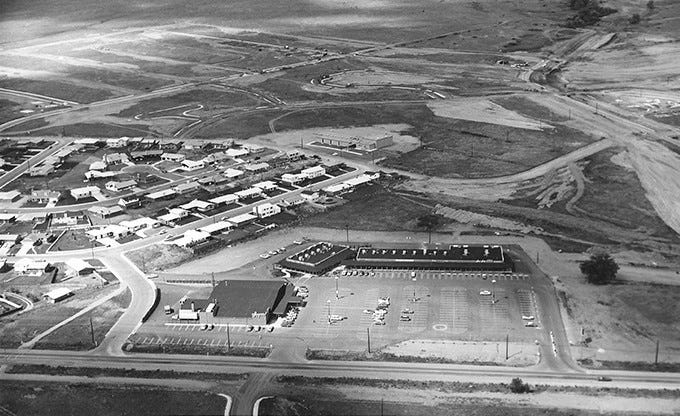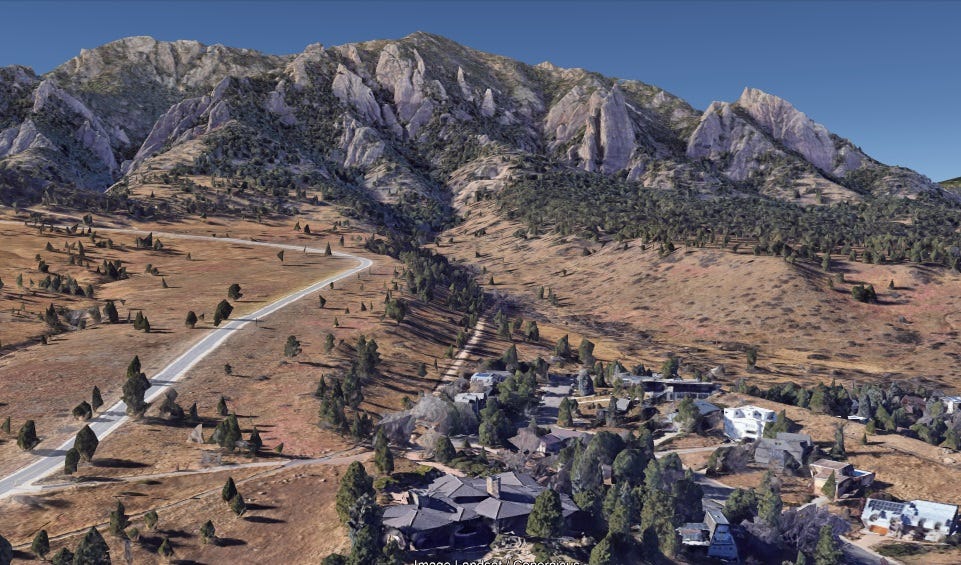Afternoons with Janine, cont.
Experiencing 2023 with someone who experienced the horrors and mass displacement of World War II a continent away is a rare opportunity
Six weeks ago, I mentioned passively pursuing a coyote in South Boulder during an otherwise routine run partly on government land and partly in some of the priciest neighborhoods in a pricey city. This experience was mostly an excuse to review some of the area’s developmental history, much of which I gathered from the mouth of a 98-year-old friend who has lived in the South Boulder house—among the first constructed on what was then a dead-end dirt road—since 1963.
Janine, born in France in 1925, was living in Paris when World War II began to spread across Europe c. 1939. When she was only 15 or 16 herself, she was placed in charge one day of escorting a much younger girl to a birthday party, a trip that involved a short train ride. This little girl had a Star of David attached to her blouse, not because she or her parents wanted her to. It’s hard for me to figure out what is most fundamentally fucked up about this apparently mundane-at-the-time scenario: that a girl was forced to advertise being a disposable societal outcast, that a teenage girl was put in sole charge of taking her to a party, and that an unknown number of adult Parisians just watched and kept their mouths shut like it was nothing.
Not long after that, Janine found herself sitting in the window of her apartment—one of three on the second floor of the structure—watching an unending parade of people slowly filter into Paris from the north, citizens displaced from Belgium and elsewhere as the Germans sawed their way through the continent. Janine says that the one memory that stands out the most from this dismal motif is someone pushing an older person in a wheelchair. Who knows how far they had come, and wheelchairs in those days might as well have been made of lead. I’m pretty sure these roads were not paved, and bottled water was hard to come by in those days, even Evian.
Soon after that, Janine was sitting in her apartment one night when the police arrived outside. Shortly before, the Jewish family in the apartment on one side of them had fled without announcement. The family on the other side, also Jewish, was still there. Their name was Reis, and the police were there to collect them. Janine says the whole process took perhaps ten minutes. She watched out the window down at a narrow and darkened street as the police ushered the Reis family into their vehicle and took them, in all likelihood, to the Drancy concentration camp, a grim waypoint for Jews who would soon be transported east toward their deaths.
Janine and her family soon had to flee Paris themselves. She soon met a man her age named George, a Jewish man whose family had escaped Russia and one of the multiple purges of Jews that were carried out there over the centuries, before and obviously independent of the Nazi-led Holocaust.
Humanity has changed in the past eighty years, but as every news channel is presently advertising and denying at the same time, it has yet to move past its willingness to commit mass-scale solecisms, including human extinctions, for comparatively marginal property and other gains.
George and Janine were married in 1947 and emigrated to the U.S. a year later, originally settling in New York City before making their way into the Rocky Mountain Foothills. It sounds as if George, though very well educated, was a merry prankster, doing things after my own heart like showing up on a lark at, say, a Pentecostal church service just to see what all the fire and brimstone was about.
Unfortunately, George died of complications of phlebitis at the age of just 37. At the time, warfarin (Coumadin) had been in use as a “blood thinner” for nearly a decade, and U.S. President Dwight David Eisenhower was one of its earliest famous recipients. But from what I can gather, it was not until the emergence of Richard M. Nixon’s serious problems with phlebitis beginning in 1964—less than four years after Nixon was narrowly defeated by John F. Kennedy in the U.S. presidential election and around five years before he would ascend to the presidency—that physicians began to use warfarin as a treatment for phlebitis specifically. Had Goerge’s leg not betrayed him for another year or two, he might have lived a far longer life. He is buried in a nice patch of Green Mountain Cemetery.
Janine and George’s son Alex, who grew up in the South Boulder home with his mother, stepfather, and (eventually) two half-sisters, is in the area for the holidays and went skiing last week with a friend from childhood who grew up across the street and whose father was instrumental in the creation of the Federal Aviation Administration, a government agency that later became the whore of the airline industry, in 1958. In the mid-1960s, Alex and this now-longtime friend would clamber up the bulldozed bed of the nascent NCAR Road.
The arrival of the NCAR Mesa Laboratory—approved as a project in 1960 but not completed until 1967, and designed by I.M. Pei, who would soon go on to botch the John Hancock Tower in Boston—forced the extension of Table Mesa Drive westward and uphill about a half a mile, where it met what had been the dead end of Vassar Drive. Construction on the Table Mesa Shopping Center—today the site of a King Soopers supermarket where ten people were killed in a March 2021 shooting spree, once the home of an Eaker’s Department Store—began in 1961.
The top photo in the pair below shows South Broadway in the foreground and the mostly empty land behind (west of) the still-small mall (source). The bottom photo is a Google Earth capture from today from the same perspective. Table Mesa Drive is in the top right in each photo, with its median constructed to carry Bear Creek down to and under South Broadway.
The image below shows the land just west of where Table Mesa Drive becomes the NCAR Road as it passes Vassar Drive. This perspective makes it impossible to tell that the massive house at bottom center sits higher than any of the other houses in the cluster behind it, as these houses, or mansions, are on the downslope leading to Skunk Canyon Creek.
There seems to be a modest geology lesson in the image, also a Google Earth capture: Skunk Canyon Creek was obviously far more than the thin trickle it is at most times of year today.
When I pick up the Boulder narrative again, the tone will shift largely toward contempt, mockery, and derogation, and the content will necessarily center on dive-dive roastings of a coterie of unwittingly vulnerable douchebags operating within several local ZIP codes. This plan allowed me the luxury of keeping this chapter of the narrative anodyne and unremarkable without brooding over the result.




